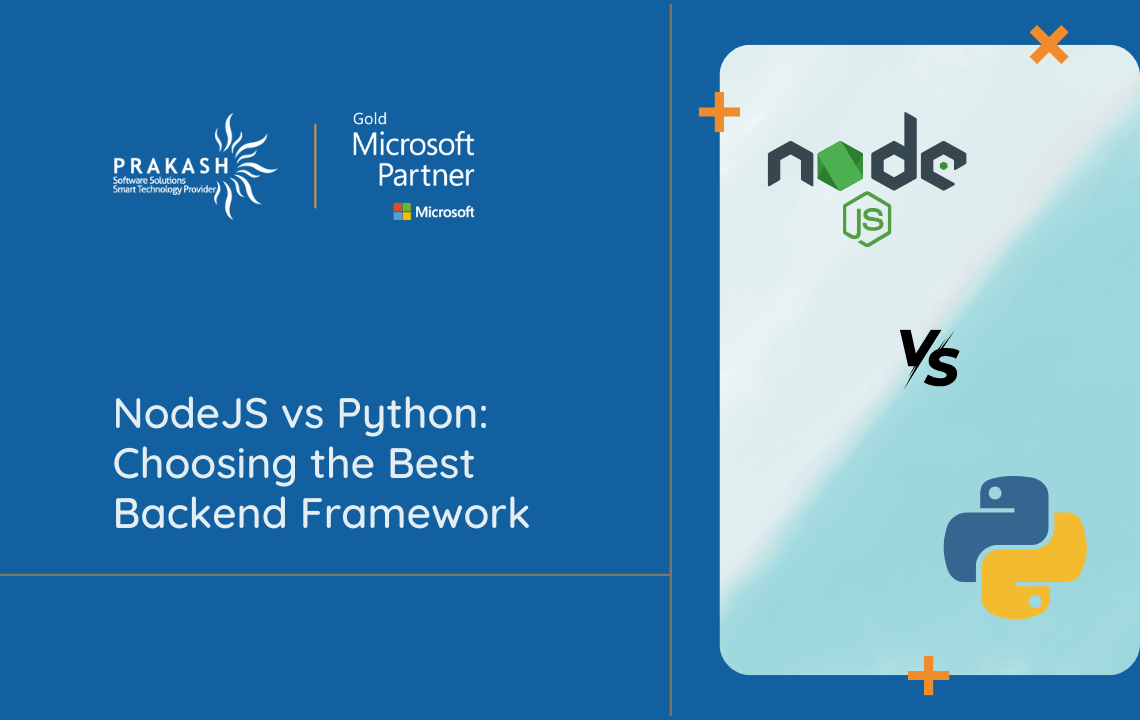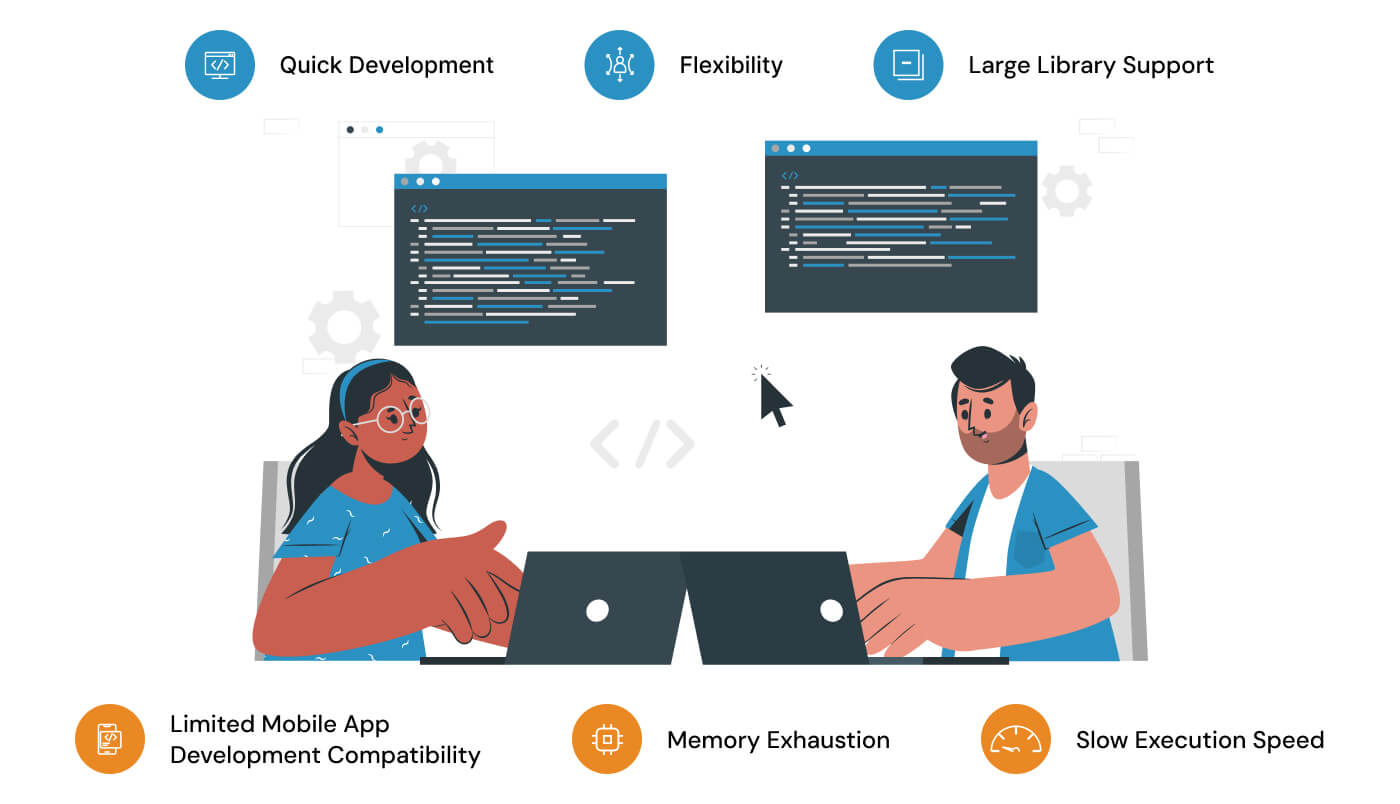
NodeJS vs Python: Choosing the Best Backend Framework
Node.js and Python are often juxtaposed in web development due to their extensive adoption. Prior to making a decision, a thorough comparison is imperative.
While some developers opt for a backend technology based on their familiarity or training, this might not always be optimal for businesses. Alignment of language, environment, and tech stack with project needs is crucial.
Choosing the appropriate backend technology is vital, impacting performance, resource allocation, deployment, scalability, and project outcomes.
Despite Node.js and Python’s popularity in server-side development, they originated at distinct times and for different purposes, making the decision between them challenging.
The article compares Node.js and Python, offering insights to help readers make informed decisions.
We will learn:
- Introduction to Node.js and Python
- Performance Comparison: Node.js vs Python
- Evaluating the Pros and Cons of Node.js and Python
- Comprehensive Comparison: Node.js vs Python
- Distinguishing Node.js and Python for Web Development
- Practical Use Cases for Node.js and Python
- js vs Python for Backend: Choosing the Right Tool for the Job
- Key Takeaways: Node.js vs Python in 2024
Let’s get started.
Introduction to Node.js and Python
When considering Node.js vs Python, it’s essential to understand their fundamental differences.
Node.js – Node.js leverages JavaScript as its core runtime, ideal for web server interaction and optimizing resources. Conversely, Python is a versatile, high-level language renowned for its vast libraries and object-oriented design, fitting for various project types. Some of which includes big data, AI development, automation, and backend systems.
Node.js scales efficiently with event – Driven architecture, managing concurrent requests without I/O blocking. Many development teams prefer Node.js for its ability to utilize JavaScript across both client and server-side environments.
Python – Contrastingly, Python’s extensive development over nearly three decades has fostered a rich ecosystem of libraries, APIs, and tools. Its adaptability supports a range of programming paradigms, rendering it a favored option for enterprises spanning different sectors.
The selection between Node.js and Python ultimately hinges on the precise needs of the project. Node.js excels in situations requiring robust scalability and effective management of concurrent tasks. While Python’s extensive community support and rich ecosystem make it an ideal choice for businesses with diverse application needs.
Performance Comparison: Node.js vs Python
This section of the blog post will delve into the statistical disparities between Node.js and Python. Node.js is favored for web application and website development, whereas Python finds its niche in backend applications, machine learning, and numerical computations.
Node.js Statistics:
- Statista ranks Node.js as the sixth most popular and widely used language for development.
- Approximately 85% of business owners opt for Node.js in their web app development endeavors.
- Development costs see a reduction of nearly 58% when employing Node.js for application development, accompanied by a significant performance boost of 50%.
- The average hourly rate for hiring a Node.js developer ranges from $18 to $38.
Python Statistics:
- Statista identifies Python as the third most preferred and highly utilized programming language for application development.
- Python is instrumental in the creation of applications related to artificial intelligence, machine learning, and various other domains.
- According to Upwork, Python developers command an average hourly rate ranging from $20 to $40.
Evaluating the Pros and Cons of Node.js and Python

Advantages of Node.js over Python:
Flexible Microservice Development : Node.js facilitates the creation of microservice architectures by offering a package manager with abundant components. This enables developers to efficiently work on multiple modules simultaneously, ensuring streamlined testing processes and product quality maintenance.
Strong Technical Stack : Leveraging JavaScript’s capabilities, Node.js grants access to the entire JavaScript stack and resources. Supported by a vibrant community, Node.js enables seamless app development with the MEAN technical stack, delivering robust front-end and back-end support for scalable projects.
Cost-Efficiency : Node.js’s compatibility with both front-end and back-end development reduces the need for separate resources, thereby cutting down overall development costs and accelerating the development process without compromising quality.
Disadvantages of Node.js:
Unstable API : Node.js’s frequent API switches can lead to backend incompatibilities, resulting in instability and challenges in adapting to code changes.
Callback Hell : The asynchronous nature of Node.js often leads to nested callback functions, causing callback hell. This diminishes code quality and complicates troubleshooting and maintenance.
Inability to Process CPU-Bound Tasks : Node.js’s single-threaded nature restricts its ability to efficiently execute CPU-bound tasks, leading to system slowdowns and significant delays in processing multiple requests.

Advantages of Python:
Quick Development : Python’s readability and swift code interpretation accelerate the development cycle, requiring less code compared to other languages and facilitating the creation of fast applications.
Flexibility : Python’s compatibility with various programming languages and platforms allows seamless integration of tools and languages as needed during product development, enhancing flexibility and adaptability.
Large Library Support : Python boasts extensive library support, catering to diverse application development needs such as game development, web development, and machine learning. These libraries facilitate code reuse and simplify custom development tasks.
Disadvantages of Python:
Limited Mobile App Development Compatibility : Python is not a preferred language for native mobile app development, as it lacks compatibility with iOS and Android platforms.
Slow Execution Speed : Python’s line-by-line code execution approach contributes to slower execution speeds compared to other languages, impacting overall web application performance.
Memory Exhaustion : Python’s high memory consumption can lead to memory exhaustion issues, compromising application speed and performance.
Comprehensive Comparison: Node.js vs Python
Node.js excels in speed and is suitable for building both client and server-side network applications, thanks to its ability to handle high memory demands. Conversely, Python, while not ideal for memory-intensive applications, shines in backend development scenarios.
Let’s delve deeper into the detailed differences between Node JS vs Python.
| Node JS | Python |
|---|---|
| Capable of catering to both front-end and back-end development requirements. | Efficient for developing applications with minimal code requirements. |
| Reduced code readability stemming from the issue of callback hell. | Offers exceptional code readability. |
| Interpreter for JavaScript | Interpreter for PyPy |
| Extensively favored for real-time application development | Extremely favored for intricate software development involving AI/ML and scientific computations |
| Ideal for memory-intensive tasks | Ideal for the development of large-scale projects |
Distinguishing Node.js and Python for Web Development
Choosing between Node.js and Python for backend development can be challenging, especially considering both are highly favored for digital product creation. Let’s delve into a detailed comparison Node.js vs Python: Best Languages to Develop REST API.
Node.js excels in performance, offering compatibility with multitasking and maintaining server speed due to its utilization of the fastest JavaScript engine. Additionally, it efficiently manages large data flows.
On the contrary, Python’s performance may lag behind Node.js, as it is not inherently parallel-compatible, leading to potential speed slowdowns. However, Python still facilitates rapid application development.

Learning Curve:
Node.js : With a manageable learning curve, especially for those familiar with JavaScript, newcomers may face hurdles with installation and documentation due to its event-driven programming paradigm.
Python : In comparison, Python boasts a simpler learning curve. Its straightforward syntax and concise code make it more accessible for developers, even those new to programming.
Community Support:
Node.js : Node.js benefits from a large, active community of experienced users. With significant engagement on platforms like GitHub, Node.js users can access valuable support and resources.
Python : Despite being an older language, Python also boasts a globally active developer community. While not as large as Node.js’s community, Python developers still offer valuable assistance and resources.
Error Handling:
Node.js : Node.js’s multitasking capabilities simplify error handling during application development, enhancing the debugging process.
Python : Although lacking multitasking features, Python’s straightforward syntax makes error resolution more convenient for developers.
Scalability:
Node.js : Leveraging single-threaded processing for non-blocking I/O, Node.js achieves remarkable scalability across servers, optimizing performance.
Python : Hindered by the Global Interpreter Lock, Python faces scalability limitations in large projects, contrasting with Node.js’s prowess.
Node.js prioritizes performance, scalability, and error management; Python emphasizes simplicity and ease of learning. The choice between them hinges on project needs and developer inclinations.
Practical Use Cases for Node.js and Python
According to the one survey, Node.js stands out as the most prevalent web technology, while Python ranks as the fourth most commonly used programming language.
Node.js: Node.js development is the preferred choice for projects requiring real-time data transmission or handling heavy client-side functionalities. Its efficiency in data streaming surpasses Python, making it ideal for applications such as:
- E-commerce platforms
- Games and 3D graphics
- Content management systems
- Chatbots
- Prominent enterprises utilizing Node.js for their applications include Amazon, LinkedIn, Tumblr, PayPal, and Netflix.
Python: Although Python may not match Node.js in speed, its concise code, extensive documentation, and large developer community make it a preferred language for various projects. Python finds extensive use in:
- Big data analysis
- DevOps and testing automation
- Scientific and engineering applications
- Government technical projects
- Notable organizations leveraging Python include NASA, Reddit, Facebook, Google, Pixar, and Spotify.
In conclusion, both Node.js and Python offer distinctive advantages and cater to a wide range of high-end use cases. Thus, both deserve recognition for their versatility.
Node.js vs Python for Backend: Choosing the Right Tool for the Job
Based on JavaScript, Node.js is widely utilized in diverse application development spheres, spanning front-end and back-end operations. It serves well in mobile backend as a service, mobile applications, desktop applications, IoT solutions, and Cloud solutions. Conversely, Python, renowned for its easy readability, proves ideal for application development across all platforms except for mobile app development. Particularly, Python shines in cloud and IoT application development scenarios. Let’s discern when to opt for Node.js or Python for backend development.
When to Use Node.js: Node.js is highly recommended for scalable applications due to its foundation on Chrome’s JavaScript runtime environment. It excels in delivering speed and performance, making it an excellent choice for Real-time Applications, high-load apps, e-commerce platforms, and more.
When to Use Python: Python, as one of the oldest programming languages, boasts extensive libraries that provide comprehensive support for various testing tools, web frameworks, data analytics tools, and more. It boasts one of the largest ecosystems in the programming community. Therefore, if you aim to develop applications in fields like Big Data, AI/ML, and GUIs (Graphical User Interfaces), Python emerges as the optimal choice.
Key Takeaways: Node.js vs Python in 2024
Application development plays a pivotal role, particularly when aiming to enhance business operations. In 2024, choosing Python or Node.js depends on business owners’ desired features for their applications. Both Node.js and Python offer unique advantages and disadvantages that must be carefully weighed in the development process.
Hence, it is imperative to initially comprehend the nature of your business. By identifying your business needs, you can then select the most suitable app development company, such as PSSPL, which can provide comprehensive clarity by understanding your requirements and offering tailored solutions. This approach resolves any remaining dilemmas between Node.js and Python. If you have further questions, feel free to contact us.
Happy Reading!!



